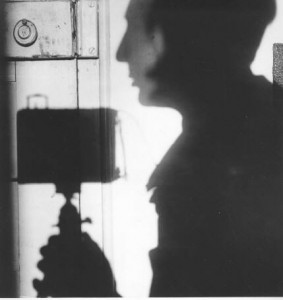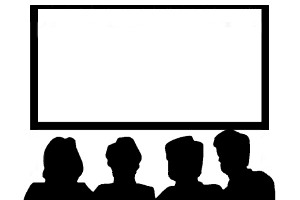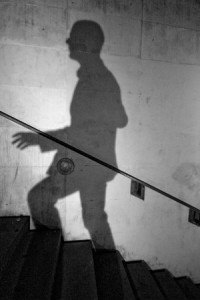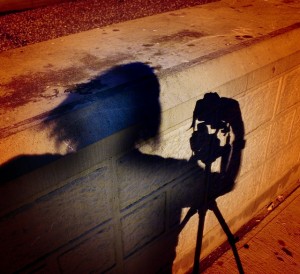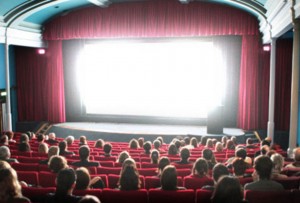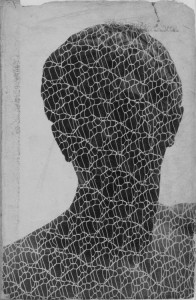A thesis submitted to the Faculty of Graduate Studies in partial fulfillment of the requirements for the degree of Master of Fine Arts, Graduate Program in Film and Video, York University, Toronto, October 1996. (Excerpt)
For the most part this film is not really a motion picture because (except for the brief silent picture of landscape spliced onto the end) it does not have any pictures. Just as Wavelength can be seen as an exploration of the zoom, White Museum is an exploration of the voice-over. The film consists of a white screen and a soundtrack. To those who understand the technical procedure of making a film, it is quickly evident that Hoolboom recorded his monologue and had an optical soundtrack made at the lab. At the time, this process would have cost $0.25 per foot, a total of $300 for a thirty minute “finished” film. This is Hoolboom’s last truly minimal film. As I hope to argue the deviations White Museum makes from the minimal film norms would mark a transition point in minimal filmmaking in Canada.
Hoolboom began making films in the minimal tradition in the early eighties. In Self Portrait with Pipe and Bandaged Ear (1981) he presented black and white pixilated images of such things as street signs. Significant portions of the film were made up of black and white frames cut between the other images. There was no movement or flow in this two minute film. In the same year he made the ten minute Now, Yours (1981) which refused to begin. The count down, traditionally ending at “2,” becomes a count up, from zero to fifty nine. This component of the film medium, the countdown, is usually hidden from the audience’s view by the projectionist as it is meant only as a projection aid. As the audience watches these numbers they think more about the projectionist and the venue in which they sit than about lack of content. This is not a new idea. American Bruce Conner used repeated academy leader countdowns in his 1958 film A Movie. Even so, Hoolboom persevered in creating variations of many tried and true radical conventions in his other early films.
The rest of Now, Yours is made up of rephotographed film and video images, many bleached and painted on. Over these images, Hoolboom’s voice tells us about his intention to show us eleven films “so brutal they haven’t been released for years.” However, he frustrates our expectations by showing none of these films. Instead he concludes with an Ontario travel film. By doing this, Hoolboom draws further attention to the fact that we are watching a film, that the form is the content. His awareness of Sitney’s definition of structural film is obvious as Hoolboom plays with each defined characteristic. He even anticipates arguments about the relevance of his films by answering that challenge in his soundtrack, “If you had nothing to say, would you be on film?”
In 1986, Hoolboom took the knowledge he’d learned and skills he’d developed about the materials of film and created White Museum. On the one hand, it is a minimal film which openly displays and discusses its own form, a straightforward minimal/structural film. However, it can also be interpreted as Hoolboom’s transition away from structuralism towards poetic films. His later films are filled with anecdotes (Mexico, 1992), psycho-dramatic events (Precious, 1994) and even scripted narratives played out with actors (Kanada, 1993). The transition Hoolboom underwent hinged on his realization of the importance of storytelling to him and to his viewers.
One of the first stories Hoolboom tells in White Museum is about film. It tells us of Hoolboom’s long-time interest in the material and processes of film. He says that his favourite time at a movie is “when the projectionist is a little hung-over so he runs all of the head leader on the screen so you see the white at the beginning and the countdown. It’s at that moment that the film is completely pure for me because it’s exactly what I want to see.” This leads us to re-read his film from five years earlier, Now, Yours, and the countdown he revealed to us there. In this new light, Now, Yours is a nostalgic look at childhood and his days in movie theatres. By giving us the tools to reinterpret his past work as subjective, Hoolboom ensures that he will not return to those forms again. If he were to make a new film with a countdown leader within it, we would no longer interpret it as a structural look at the film form but as a poetic yearning for the past.
The key element of White Museum is its clear disregard for motion picture conventions. There is no picture so there is no motion. This occurs, as Hoolboom claims within the text of the soundtrack, because he could not afford to put a picture with the film. Although he tells us he simply can’t afford to put images on the film, a more keen understanding of the materials is needed than he implies. The making of the optical soundtrack, like the one from White Museum, is usually performed by the lab as a step towards performing the much more expensive tasks involved in printing a finished film. Sound, usually from a magnetic tape, is played into a machine, vibrating a sensitive metal plate through which light passes creating photographic markings along the edge of an otherwise blank film. The film which is used for this is black and white optical film stock which is the least expensive 16mm film stock sold by Kodak. These markings, closely akin to the bumps in the groove of a phonograph record, can be retranslated into sound by the projector. As neither Kodak nor the laboratories assume that anyone would use just the optical sound film as a finished film to be released, the charge for this service is not excessive.
While one might expect that the voice without picture would be akin to listening to a record playing, Hoolboom does not allow his audience that familiar comfort. He continuously reminds them about the screen and the act of looking. He makes them look at nothing but gives them something to think about: “There is no need to make things when everything exists already.” “Hearing comes before seeing.” “If it true that a picture is worth a thousand words then why does it have to be a saying?” It is this pondering about absence which has always been the minimal film’s strength.
However, even though the audience is told that there is no image, the promise of one forthcoming (by both Hoolboom in his narration and in the years of conditioning a movie spectator has undergone in those theatre seats) glues everyone’s eyes to the screen. The anticipation of the image, when the dark theatre deprives us of any other is overwhelming. When I saw this film with a large audience in May 1995, with great effort I turned away from the screen and looked around at the others sitting there. I could see them all clearly illuminated by the reflection from the bright screen. They were all staring intently towards it. Even when the house lights were turned on in the middle of the film, as the voice on the soundtrack requested the projectionist to do, the audience was hesitant to look away from the blank screen. The theatre has created a virtual temple where the audience would not allow their wandering eyes or loose tongues to desecrate. It is quite apparent that the sound, played without the projected light, would not have captivated the audience in the same way. Hoolboom is aware of the power of the projector, citing 1960s Canadian painter and filmmaker Keewatin Dewdney in program notes a few years later: “The projector, not the camera, is the filmmaker’s true medium… The very use of the camera as a filmmaking tool has imposed the assumption of continuity on film.”
After White Museum, Hoolboom employed an increasing number of narrative story elements in his films, without necessarily relying upon all narrative film conventions. He would use the voice and the image to explore the world he saw around him instead of the limited world he saw only in the film editing room. White Museum is the transition point. In form, this film is purely structural. In content, it is both modern in its discussion of itself (self-referential) and lyrical in its wordplay and associations.
